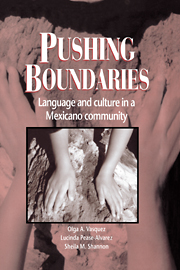Book contents
- Frontmatter
- Contents
- Foreword
- Preface
- Chapter 1 INTRODUCTION
- Chapter 2 EASTSIDE: A MEXICANO COMMUNITY
- Chapter 3 HOME AND SCHOOL CONTEXTS FOR LANGUAGE LEARNING
- Chapter 4 BILINGUAL CHILDREN CROSSING CULTURAL BORDERS
- Chapter 5 NEGOTIATING CULTURE AND LANGUAGE IN THE HOME
- Chapter 6 MOVING TOWARD A RECOGNITION PERSPECTIVE
- Chapter 7 MEETING THE CHALLENGES OF DIVERSITY
- Notes
- References
- Index
Chapter 6 - MOVING TOWARD A RECOGNITION PERSPECTIVE
Published online by Cambridge University Press: 26 March 2010
- Frontmatter
- Contents
- Foreword
- Preface
- Chapter 1 INTRODUCTION
- Chapter 2 EASTSIDE: A MEXICANO COMMUNITY
- Chapter 3 HOME AND SCHOOL CONTEXTS FOR LANGUAGE LEARNING
- Chapter 4 BILINGUAL CHILDREN CROSSING CULTURAL BORDERS
- Chapter 5 NEGOTIATING CULTURE AND LANGUAGE IN THE HOME
- Chapter 6 MOVING TOWARD A RECOGNITION PERSPECTIVE
- Chapter 7 MEETING THE CHALLENGES OF DIVERSITY
- Notes
- References
- Index
Summary
Some of the abilities and experiences of Mexicanos from the community of Eastside described in previous chapters are grounded in uniquely Mexican patterns of knowing and interacting. Some ways of using and thinking about language, however, are shared across cultures, and some are shaped by the users' experience of living and working in multiple cultures. Children and parents are key players in one another's language socialization. Parents perceive themselves to be deliberate and central participants in their children's language development, but children, too, are responsible for helping adults negotiate transactions with outside institutions. Thus, language socialization is a mutual endeavor, with adults and children sharing responsibility as they negotiate language and culture.
Language socialization among Eastsiders is rife with developmental opportunities. The everyday conversations that involve Nestor and Jennifer with their adult conversation partners provide them with knowledge and skills that they can draw upon as they learn about the details of their language and the modes of discourse that they will later encounter as readers and writers. Through encounters with English, children learn to talk about a wide range of information beyond that found in the east side. They extend and further develop their bilingualism and multiculturalism through intercultural transactions that require them to draw upon their languages and cultures to negotiate meaning. Moreover, the intellectual feats involved in these events entail the use of sophisticated cognitive processes that enable children to maneuver successfully in and out of a variety of linguistic domains.
- Type
- Chapter
- Information
- Pushing BoundariesLanguage and Culture in a Mexicano Community, pp. 142 - 180Publisher: Cambridge University PressPrint publication year: 1994



